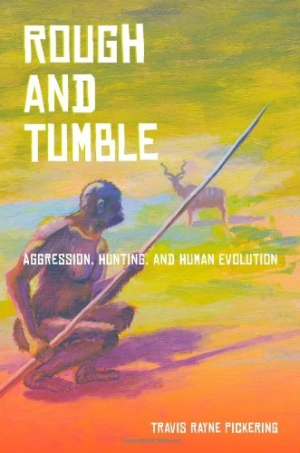Rough and Tumble
Aggression, Hunting, and Human Evolution
Anthropologist challenges notion that human ancestors were defined by “killer ape” aggression; weapons reflected problem-solving abilities.
In his new book, Rough and Tumble, anthropologist Travis Rayne Pickering argues that, while hunting was a major step in the evolution of human ancestors, scientists have overstated the role of aggression. He questions many of the conclusions reached by researchers about hominin remains, and he uses fossil evidence to suggest alternate possibilities. Pickering provides a rather short, but informative, history of scientific thought on the diet and hunting ability of hominins. He also explains the work of several pioneers in the field while discussing specific fossil finds and how the data derived from those fossils drove theories about early hominin behavior.
Much of Pickering’s book is a reaction against the “killer ape” hypothesis of Raymond Dart. Dart argued that human evolution was driven in large part by aggression and violence, suggesting that human ancestors were more aggressive than other primates and that war, violence, and hunting all demonstrated heightened aggression endemic to humans. Pickering argues that the advent of weaponry actually meant hominin hunters were less aggressive, as weapons allowed them to be slightly removed from the more visceral hunting methods of other primates and predators. Obviously, aggression is part of human evolution, he believes, but it is not a defining characteristic that differentiated humans from other species.
For example, he cites the behavior of chimps who hunt bushbabies by jamming sharpened sticks into holes to skewer the smaller primates, but then often have to kill the wounded animals as they fight back. He also explores how cases like the ambush “gang killings” at Gombe—a group of male chimps systematically and brutally kill all the males in a smaller group—show that chimps normalize a more aggressive form of hunting than do humans, which contradicts the notion of humans as uniquely violent. Pickering explains how hominin weapons increasingly gave hunters more distance, starting with long spears and projectile weapons, and including modern humans’ adoption of arrows and, later, guns. He discusses how weapons allowed early hominins to overcome their inherent handicaps as hunters—allowing them to kill larger, faster, or more powerful species—and how they reflect problem-solving and intellect rather than just raw aggression.
The narrow focus of Rough and Tumble allows Pickering to effectively challenge aspects of the “killer ape” hypothesis, though his argument comes across more as a series of important distinctions than a full rejection. He also raises interesting questions about the data compiled by other scientists regarding hominin remains.
Reviewed by
Jeff Fleischer
Disclosure: This article is not an endorsement, but a review. The publisher of this book provided free copies of the book to have their book reviewed by a professional reviewer. No fee was paid by the publisher for this review. Foreword Reviews only recommends books that we love. Foreword Magazine, Inc. is disclosing this in accordance with the Federal Trade Commission’s 16 CFR, Part 255.

